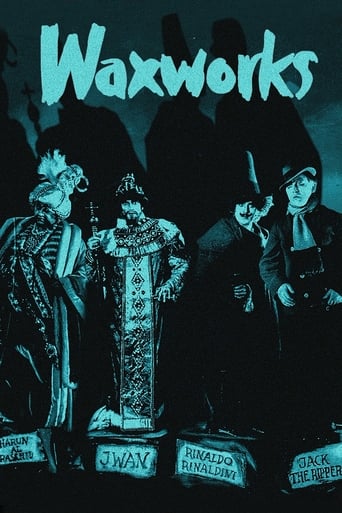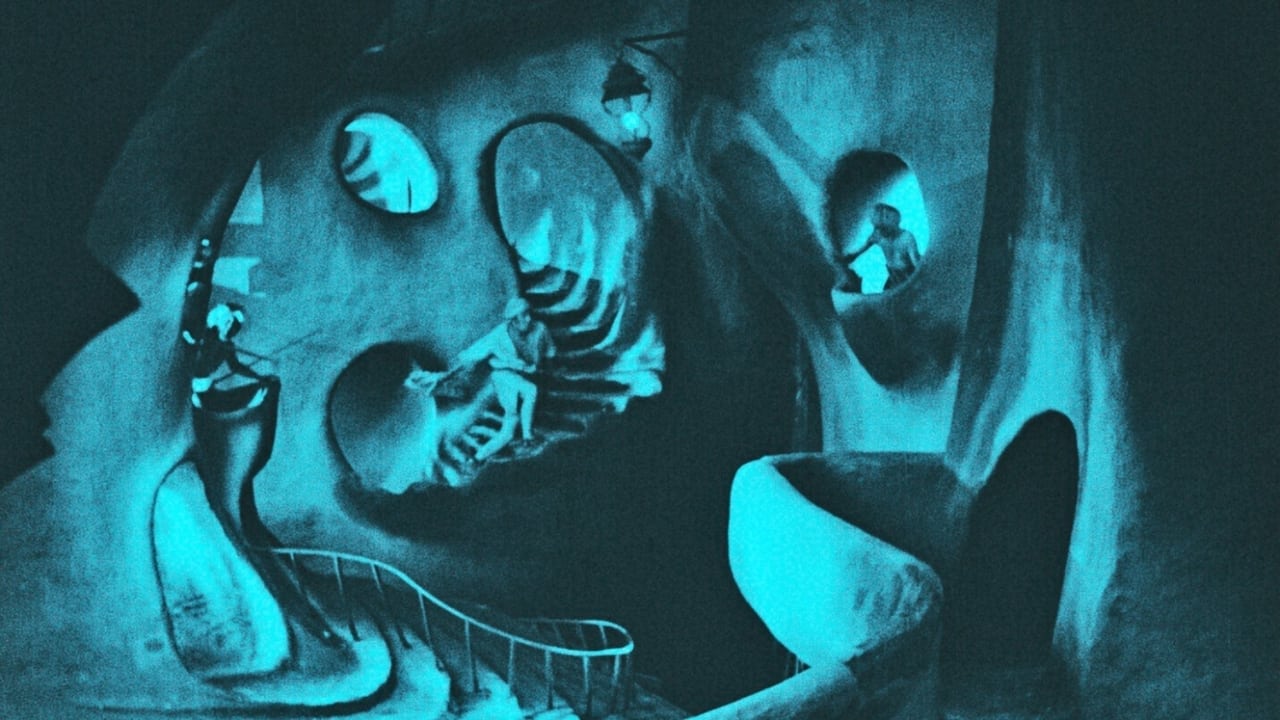tomgillespie2002
When a young writer (William Dieterle) sees an advert in the paper requesting somebody with a big imagination, he takes the job and finds himself in a wax museum, where the owner asks him to write stories about his three finest works. His models are of Harun al-Rashid, Ivan the Terrible, and Spring-Heeled Jack, and when Harun's arm accidentally drops off, the writer's imagination starts to wander, and he sets about telling his fantastical tales.Although in essence a horror film, Waxworks is more of an anthology film, juggling genres and tones to fit the mood of the individual piece. While this can be an inventive and successful approach (Creepshow (1982), for example), it can also damage a film's flow if not carefully constructed, risking leaving one story in another's shadow if they also vary in quality. Waxworks suffers for this unfortunately, mainly due to the unevenness in the stories' running times, and the sudden shifts in tone. The stories increase in quality as the film goes on, which is a good thing, but in the case of Waxworks, it leaves a disappointing taste in the mouth given the running time of the final piece is within the blink of an eye.The first story has German silent screen legend Emil Jannings playing Harun al-Rashid, who is informed by his adviser that the most beautiful woman he has ever seen (played by Olga Belajeff) is married to a baker in the city. Rashid goes to win the love of the beauty, but she has set her husband (Dieterle) off to prove himself as a man by stealing the wishing ring from Rashid. Taking a fantasy approach, this story also has a sprinkling of comedy. Jannings if a colossal beast, as you would expect, and brings his dramatic chops to a rarely-seen comedic role. Yet this section drags, and the beautiful expressionist sets don't manage to save it from becoming a silly pantomime.Another German silent icon, Conrad Veidt, plays Ivan the Terrible in the second section, which focuses on Ivan's insane obsession with his potion maker, who can seemingly strike death upon anyone he chooses. It has all the wide-eye operatic tones of Sergei Eisenstein's own Ivan adaptations, with Veidt proving the perfect candidate for Ivan's descent into complete madness. And the final story sees the writer fall asleep at his desk and begin a creepy dream about being stalked by a killer (Werner Krauss) in the streets. It is the final story that remains the most impressive, but sadly only lasts about four minutes.Weimar Germany brought some of the greatest screen icons and most innovative directors in cinema history to the fore during the free- spirited expressionist movement, and although by 1924 the movement was fading away, Waxworks has some fine examples. The winding, claustrophobic staircases of the city streets in the first story evoke the most popular film of the movement, The Cabinet of Dr. Caligari (1920), and in a way, Waxworks almost feels like a homage to Robert Wiene's masterpiece, employing Krauss (who played the titular character) and Veidt who both starred. There is certainly a lot to admire here from a visual standpoint, but even three silent screen giants can't save it from being a slight disappointment, given the promise shown in the final story.www.the-wrath-of-blog.blogspot.com
ackstasis
It's only when you begin to delve deeper into works of German Expressionism that you can appreciate how important and influential a film was 'The Cabinet of Dr. Caligari (1920).' It demonstrated to filmmakers and audiences that cinema is an inherently artificial medium, and so, rather than striving for realism, films should emphasise the fake and fantastic elements of their story. Though Frenchman Georges Méliès had first struck on this idea at the turn of the twentieth century, it was Robert Wiene's creative horror film that established German Expressionism as the defining artistic style of the 1920s, securing post-War Germany as cinema's most prominent innovator and paving the way for directors F.W. Murnau, Fritz Lang and Paul Leni {each of whom were later coaxed to Hollywood to share their expertise}. The hand of 'Caligari' is evident throughout 'Das Wachsfigurenkabinett / Waxworks (1924),' a fantasy/horror that is framed around a young writer's attempt to concoct thrilling tales to accompany three carnival waxwork characters - Harun al Raschid, Ivan the Terrible and Jack the Ripper.Three names come to mind more readily than most when one considers silent German actors: Conrad Veidt {'The Man Who Laughs (1928)'}, Werner Krauss {'Herr Tartüff (1925)'} and, of course, Emil Jannings {'Faust (1926)'}. It's no surprise that both Veidt and Krauss had achieved their stardom with 'The Cabinet of Dr. Caligari' four years earlier, and the parallels between that film and 'Waxworks' stretch much further than the mere casting decisions. The film, co-directed by Paul Leni and Leo Birinsky, employs grossly-exaggerated art direction {the sets designed by Leni himself} and Helmar Lerski's imaginatively-warped cinematography to highlight the fantasy in each story, even though there are very few elements that would ordinarily be considered fantastic. Emil Jannings plays the rotund Harun al Raschid, the fifth Abbasid Caliph, with a loathsome repugnance that gradually gives way to a certain likability. When his intentions towards the beautiful Maimune (Olga Belajeff) are shown to be friendly rather than sexual, he becomes an affable and cartoonish oaf.This segment is followed by the story of Ivan the Terrible (Conrad Veidt), who is driven to madness by the trickle of sand through an hour-glass, every falling grain bringing him closer to demise. Veidt plays the cruel Grand Prince of Moscow with a wide-eyed craziness that calls to mind the intense acting style of fellow-German Klaus Kinski. One of the earliest portrayals of Ivan the Terrible, this segment no doubt influenced Sergei Eisenstein when he directed 'Ivan the Terrible: Part I and II (1944).' The final story, definitely the scariest of the three, concerns Jack the Ripper also referred to as the mythical Spring-Heeled Jack for some reason, perhaps due to a translation error. Though it barely runs for five minutes, I found my heart genuinely thumping as Jack (Werner Krauss) stalked through the dream-like haze of Luna Park, as the young writer (William Dieterle) and his girl (Olga Belajeff) flee from his multiple eerie shadows, every step leading them ever-so-closer to the cold glint of his knife.The framing device around which 'Waxworks' revolves unavoidably leads to a distracting unevenness of tone, the atmosphere fluctuating between light-hearted comedy and gruelling horror. Also rather frustrating is the fact that Jannings' segment, while certainly entertaining at a satisfactory level, is afforded so much screen-time, and yet Krauss' Jack the Ripper killing-spree is wrapped up in a matter of minutes. Since a fourth character tale, about Rinaldo Rinaldini, was scrapped due to budget constraints, I suspect that funding also played a role in reducing the third act. However much of an oddity it might be, 'Waxworks' is nevertheless a visual marvel, and no shortage of imagination has been expended on the strange and exciting set and costume designs. The film certainly impressed studios in Hollywood, for director Paul Leni was subsequently lured to the United States to continue his career, after which he notably directed 'The Cat and the Canary (1927)' and 'The Man Who Laughs (1928),' before his premature death in 1929.
Cineanalyst
"Waxworks" is an early example in film history of a movie that's clearly in homage to another film--in this case, "The Cabinet of Dr. Caligari" (1920). The expressionistic stylization in the film is obviously influenced by "Caligari", and a few references to that film reinforces that, beginning with the title. The literal translation of "Das Wachsfigurenkabinett" is "The Wax Figures Cabinet"--the keyword being "cabinet". Additionally, the frame narrative is purposefully set at a carnival, although a more dimensional one than the stage setting in "Caligari".The narrative structure is closer to Fritz Lang's "Destiny" (1921), with the framing of three odd stories. "Waxworks" has the clever device of a writer of the inner stories in the framing story. And, the three biggest stars of Weimer cinema (Emil Jannings, Conrad Veidt and Werner Krauss) play the historical villains and waxworks come alive in the inner stories. For the three stories, a different expressionistic technique dominates, each relating to and enhancing their respective themes. In the Harus al Raschid narrative featuring Jannings, it's the sets (Paul Leni's sphere) with oddly shaped architecture more akin to "Caligari' than Baghdad. Especially nice is the staircase set. Rather than the horrific, dreamlike abstraction of "Caligari", however, the sets are delightfully peculiar, as is Jannings and the silly story. Low-key lighting dominates the Ivan the Terrible episode featuring a darkly paranoid Veidt, and the multiple exposure kaleidoscope imagery places Krauss's stalking serial killer everywhere.A clever film, and Leni and the other filmmakers seem to have had fun with it, which crosses over to viewers, but beyond that it's rather lackluster, not emotionally engaging as "Destiny", nor stunningly fresh as "Caligari".
arneblaze
These are three O'Henry-like stories with twist endings and although they don't add up to much, they are clever and pass the time. Jannings as a reprobate Caliph caught in a compromising moment with the baker's wife is humorous, Veidt as Ivan the Terrible caught in an inescapable twist of fate as the victim of his own cruelty and Werner Krauss as a momentary ghost of Jack the Ripper all have their moments. The Jannings story lasts 32 minutes, the Veidt 23 and the Krauss a mere 5. The most impressive thing visually are the expressionistic sets - the Art Direction deserved at least award consideration.Leni's vision was singular. Worth seeing as an oddity.


 AD
AD




